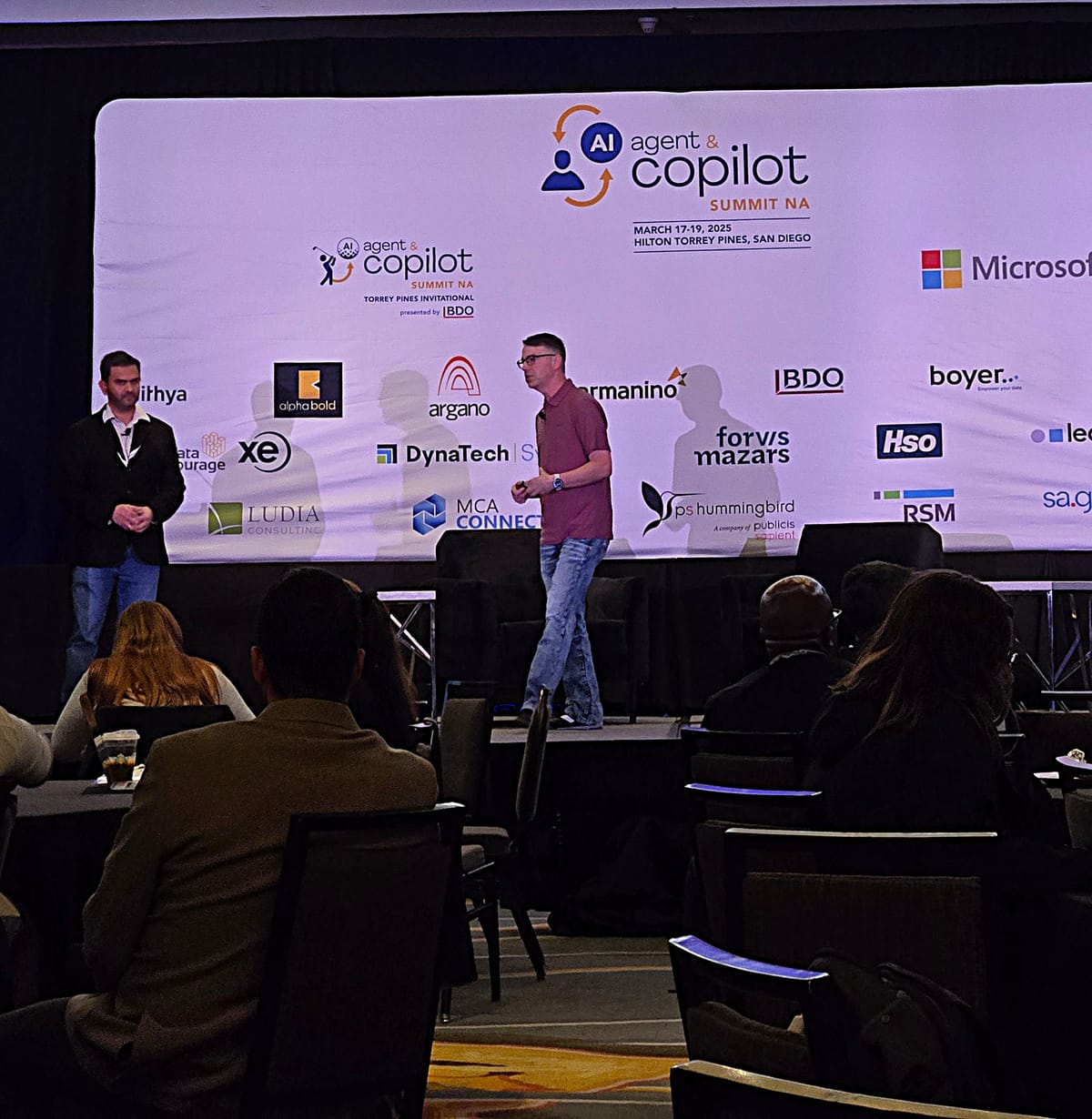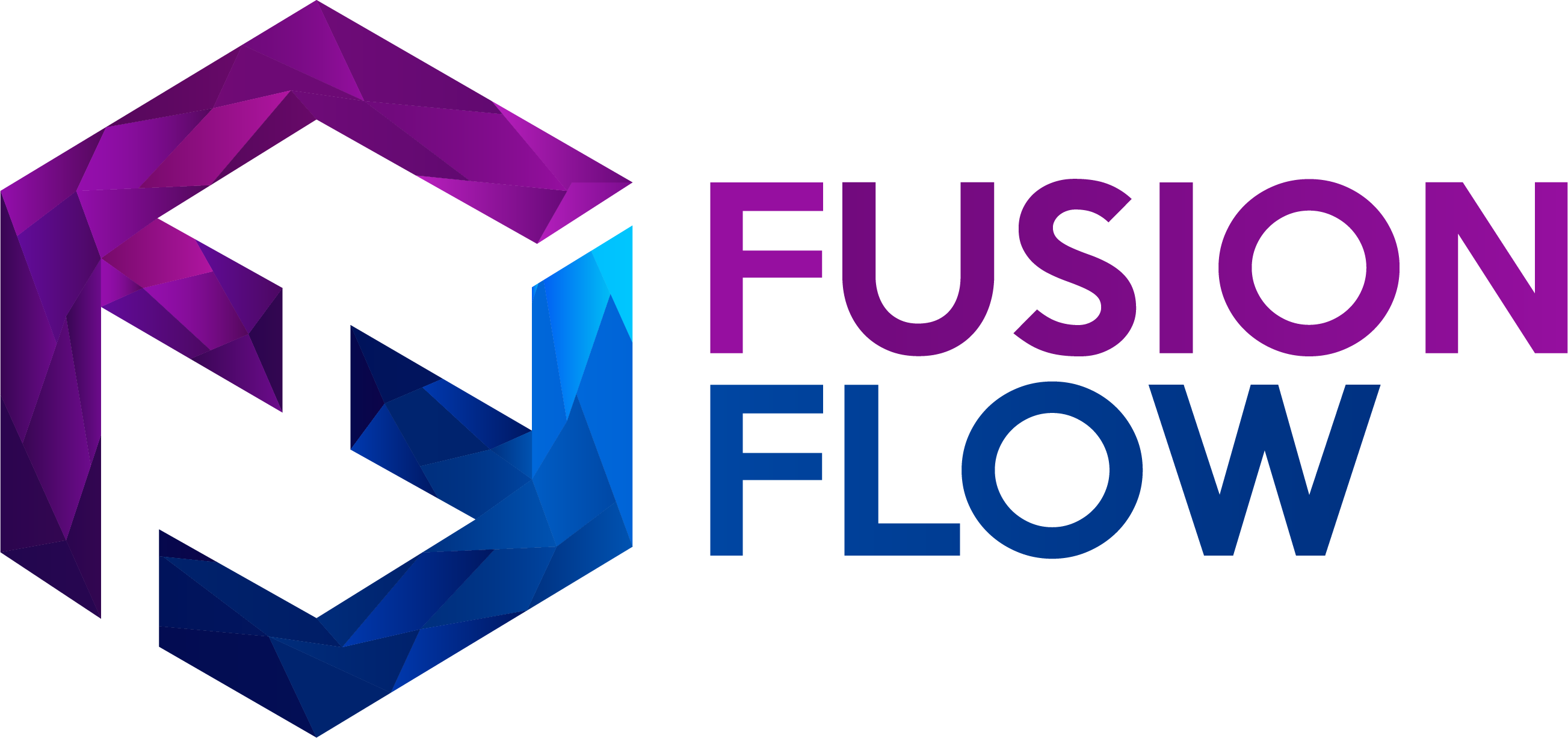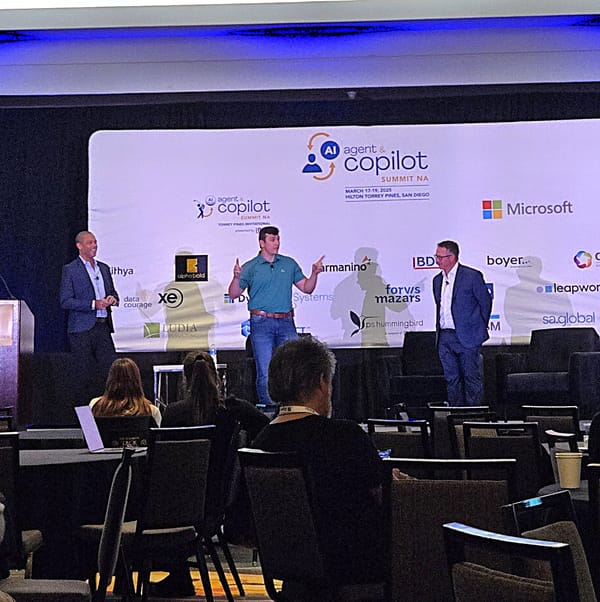Copilot Studio vs. Azure AI Foundry: How to Ship Agents Faster (and Smarter) on Microsoft's Stack
Want AI assistants that ship fast and stay flexible? Start in Copilot Studio to extend Microsoft 365 Copilot or spin up a custom agent in hours. When you need more control, use Azure AI Foundry to choose your data and model. Start simple, scale later.

If you own the AI roadmap, you face one recurring decision: build from scratch or extend what you already pay for. This AI Copilot & Agent Summit talk laid out a practical way to move fast without painting yourself into an architectural corner.
The quick takeaways for decision-makers
- Start at the commodity layer, add complexity only when needed. As one speaker said, “Start at the top of the commodity layer and work your way to complexity.”
- Use Copilot Studio to extend first-party Copilots and to build custom agents. “Copilot Studio is a SaaS based conversational AI platform… built to allow both pro code and low code.”
- Bring Azure AI Foundry in when you need custom models, RAG control, or orchestration at scale. It’s the unified place with a “model catalog… more than 1800 models” plus evaluation tools.
- Treat M365 Copilot and your custom agents as complementary. Copilots come with channel and capability constraints; your agents control the rest.
What Microsoft means by "Copilot" vs. "Agent"
Language matters.
- “When I say Copilot I mean something that Microsoft builds. When I say agent, it’s something you built.”
- Extending a first-party product (like M365 Copilot) via Copilot Studio is a Copilot agent.
- Building your own from zero in Copilot Studio is a custom agent. Default posture there: “The default answer is I don’t know.” You choose the tools and channels.
Governance, channels, cost, and capabilities differ between Copilots and Agents. M365 Copilot is built for personal productivity and speaks through the M365 interface. Your custom agent can live in your chosen channels and do the work you specify.
The agent spectrum: retrieval → action → autonomous
You're not picking "AI" in the abstract; you're choosing a capability tier.
- Retrieval-based (RAG) agents
Think "chat GPT over your data… searching [and] summarization over your data."
Use for Q&A, lookups, policies, manuals. - Action-capable agents
"I can actually go out and do a… call."
Use when you must hit APIs, update records, file tickets, create orders. - Autonomous agents
"I write a job description for my agent… give it a tool set… and it then just goes and does its job."
Use for scheduled monitoring, back-office workflows, and multi-step processes.
Pick the lowest tier that solves the problem. You'll ship faster and control costs.
Azure AI services, unified
Microsoft rebranded Cognitive Services to Azure AI services,: "first-party services" used internally by Microsoft products and available to you. Historically, these lived behind separate portals, which made multi-service apps awkward. The fix is Azure AI Foundry (formerly "AI Studio"): a "unified platform to build your AI agents" with:
- Model catalog: "more than 1800 models" (OpenAI and others).
- Evaluations: "compare the results across multiple models and then see which model is best suited" to your use case.
- Search & agents: Azure AI Search, agent services, and content safety.
Why you care: one place to choose a model, ground it on your data, evaluate quality, and wire it into your build and DevOps.
Copilot Studio + Azure AI Foundry: how they fit
Think in layers:
- Extend first-party Copilots
"You can extend it to make it your own… it's additive, it's not overrun." Example: add your CRM or ERP actions to M365 Copilot. - Build standalone/custom agents
Use Copilot Studio for "conversational orchestration." Route different intents to different tools or RAG pipelines. If you "need to have multiple RAG patterns… then I need a way to orchestrate it to send it to the right one." - Drop to Foundry when you need control
Bring your own RAG with Azure AI Search (ingest from Blob, SQL, MongoDB, etc.), control chunking/vectorization, and select specific models or fine-tuned variants. As the speaker noted, some cases can't use a commodity chunker; that's your 5% where Foundry's knobs matter. - Move between low-code and pro-code
"It doesn't mean that if I started [in] Copilot Studio I cannot… extend… into Visual Studio or GitHub. The reverse is possible." Start with natural-language Agent Builder, then add custom actions backed by your chosen Foundry model (e.g., "a fine tuned… GPT-4") and expose it through Copilot Studio channels.
Channels and governance
- Channels: first-party Copilots are channel-limited (e.g., M365 Copilot inside Teams). Custom agents can be surfaced where you need them.
- Control: Copilots come with non-removable core behaviors (like a smart speaker always being able to set a timer). Your custom agent is yours to define.
- Spend: the talk teased guidance on "message burn rates" and licensing. Track costs early; set rate limits and caching to avoid bill shock.
Practical build paths
Use these patterns to ship quickly and keep an "escape valve" open:
- Prototype in hours
"Copilot Studio is… recommended if you would like to quickly do a rapid prototype… have your agent up and running in a few hours." Start with natural-language intent, wire basic actions, demo value. - Ground on your data safely
Use Azure AI Search for RAG. Index Blob/SQL, test relevance, add citations. In Copilot Studio, point your agent to that index and set instructions for when to use which knowledge source. - Add pro-code actions where it counts
For regulated outputs or specialized formats, create custom actions in Copilot Studio that call a Foundry-hosted model: "select which particular model… this… action will be using." - Orchestrate, don't hard-wire
Route intents to the right sub-system (policies → RAG A, pricing → RAG B, orders → API). That's the conversational orchestration layer Copilot Studio gives you. - Evaluate before you commit
Use Foundry evaluations to compare models on your prompts and data. Pick for accuracy, latency, and cost. - Climb the stack only when needed
"There are no scenarios where you should [re]build from the ground up" for standard use cases. Start with Copilot Studio; fall back to Foundry and pro-code where the commodity layer can't meet your requirement.
A mental model for investing
"Microsoft is a platform selling company… You want to buy a brick, we'll sell you a brick. You want to buy a wall… a house… a neighborhood." Your job is to choose the level that meets your outcome and time-to-value:
- Need personal productivity? Extend M365 Copilot.
- Need a branded assistant in your channels? Build a custom agent in Copilot Studio.
- Need precise model choice, RAG control, or fine-tuning? Wire Azure AI Foundry into your agent.
- Need both? Orchestrate. The stack is built to work together.
Start with the fastest path to impact. Keep the door open for the 5% that needs deeper control. And remember the north star from the talk: "use the power of what we offer you at the right level… and know that you always have an escape valve."
If you need help building your AI agents, reach out to me at Fusion Flow Software.





